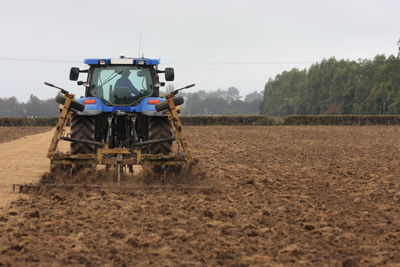
Features
Production
Research
Deep zone tillage can help in soil health
April 13, 2010 By Dan Woolley
Dr. Jude Boucher fervently believes in the superior merits of deep zone tillage over conventional tillage.
Dr. Jude Boucher fervently believes in the superior merits of deep zone tillage over conventional tillage.
 |
| Conventional tillage uses energy and labour while reducing organic matter and water infiltration, and holding in the soil. Advertisement
|
“We have a big push on to get people to use reduced tillage, mainly for soil health,” said Dr. Boucher, a University of Connecticut extension specialist on sustainable agriculture and integrated pest management, during a recent presentation.
Conventional tillage uses a lot of energy and labour, he explained, while at the same time reducing organic matter and water infiltration, and holding in the soil, plus reducing beneficial soil organisms that improve soil structure.
Conventional tillage, added Dr. Boucher, also impairs plant root health, creates poor drainage, soil compaction, plow pans, creates surface crusting and poor seed emergence, while encouraging soil erosion, and nutrient and chemical runoff.
Soil health is indicated by its density, aggregate structure, water infiltration rate and holding capacity, and large soil pore size distribution, he said.
“We have found that 89 per cent of our conventionally tilled farms had plow pans,” said Dr. Boucher. “Almost all conventional farms have plow pans.”
Most conventionally tilled farm fields also have low to medium organic matter levels and need more, he added.
In a sample of five New England farms that were conventionally tilled, all of their fields had a plow pan and all had low organic matter, said Dr. Boucher.
The five affected farmers, he noted, are now taking their first steps to restoring the health of their soils by reducing plowing impact, building organic matter, improving drainage and reducing erosion through conversion to deep zone tillage.
By converting to deep zone tillage, the farmers have cut their field preparation time by 40 to 66 per cent, said Dr. Boucher. “That is a lot of savings in labour and fuel.”
He stated that it takes a farmer utilizing conventional tillage 1.5 hours to plow and harrow an acre compared to just 30 minutes if her or she were using deep zone tillage.
The deep zone technique uses deep shanks and large coulters in a zone builder mounted on the rear of a tractor. The zone builder can also mount a seeder and residue manager.
Field prep time can also be reduced by 83 per cent by adding a fifth wheel for a planter to be hitched to the zone builder, Dr. Boucher said.
He explained that deep zone tillage creates a five inch wide tilled strip, simultaneously breaking up plow pans, warming the soil and preparing a seed bed. A deep shank or sub-soiler on the zone builder breaks up the plow pan while the zone builder’s fluted coulter cuts and prepares a strip in the killed residue/cover crop. Rolling baskets behind the coulters on the zone builder help break up soil clods to prepare the narrow seed bed. Finger-like residue managers in front of the planting shoe on the planter provide the finished seed bed.
Dr. Boucher said most of the ground between the crop rows will retain the heavy surface residue from the killed cover crop but the five inch wide tilled strip, being slightly raised, will warm faster than covered soils and will not allow surface water to generate enough speed to erode the soil.
Looking at deep zone tillage’s cost benefits, he said one New York State sweet corn grower used 60 per cent less fuel, 40 per cent less labour, and 75 per cent less nitrogen, for a savings of $55.70 per acre and a total savings of $61,315 on all his plantings.
With deep zone tillage, one Connecticut grower expanded his yield by 50 bags per acre, said Dr. Boucher. He noted that other benefits of deep zone tillage include preservation of soil moisture in a dry year, better plant start and emergence, no dry tips on sweet corn ears and very little dust or noise as a result of fewer machinery passes over the field.
Deep zone tillage will also increase yields in a wet year because it enables on-time planting for on-time harvesting, Dr. Boucher said. It can also plant low, wet fields, meaning more acres planted. It also eliminates soil erosion, eliminates dead furrows, and creates better drainage with far less phytophthera and fewer rocks pulled to the surface.
Besides cleaner pumpkins and squash, Dr. Boucher stated that deep zone tillage will give growers improved soil health, better plant health and crop quality.
Deep zone tillage requires a minimum of a 55 horsepower, four-wheel drive tractor or a 70 horsepower, two-wheel drive tractor, Dr. Boucher said, adding that weight should be added to the tractor’s front end.
“The cover crop must be really dead,” he recommended. “That is the biggest mistake growers make when they first go to deep zone tillage.”
Before performing deep zone tillage, the grower must kill the cover crop, if winter has not already done so. Dr. Boucher suggested using an application of glyphosate. Three weeks after killing the cover crop, deep zone tillage can be performed and the field planted, fertilized and treated with a pre-emergent herbicide, he added.
The change in field preparation with deep zone tillage means there will be no more need for plowing, harrowing, culti-packing or cultivating, said Dr. Boucher. The tillage technique can also be used in conjunction with no-till planting of a rotational cover crop and will eliminate any possibility of compaction, he added.
Print this page